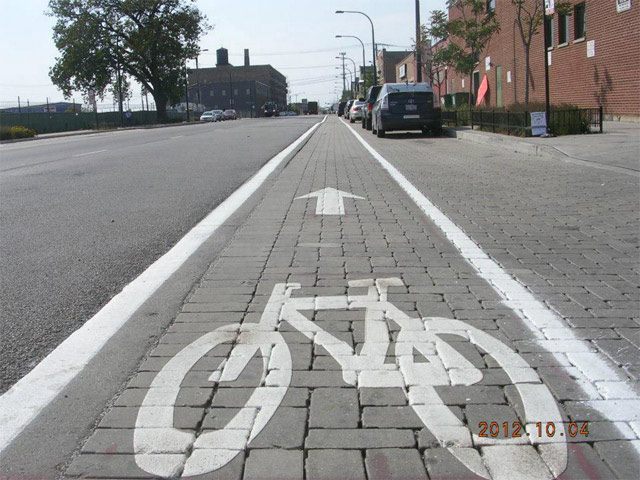Cermak Is The Future Of Chicago Streets
By JoshMogerman in News on Oct 28, 2012 8:30PM
Who says it is expensive to be green? With the smokestack of the now-shuttered Fisk coal plant in the background, the City’s Commissioner of Transportation Gabe Klein and Chief Sustainability Officer Karen Weigert announced what has been termed the “greenest street in America” on Cermak this week. While the “smog-eating” properties of the street have gotten a lot of attention, we were struck by the comparative price tag of the project. Despite a bevy of interesting features, Klein noted that the demonstration project was 21% cheaper than other similar city road projects bid out at the same time.
The 14-block stretch of road in Pilsen features bike lanes that stand as the first commercial installation of photo-catalytic cement, which absorbs nitrous oxide from the air (the technology has been used in roof tiles for a while). Perhaps more important—it is one of the first times that permeable pavement has moved out of the green alley program and into Chicago’s streetscape. That green technology has shown itself to be comparable in price to typical cement. Add bioswales and other water retaining features and this stretch of road near Blue Island diverts 80% of rainwater (it's no wonder that MWRD helped fund the project), creating a roadscape that points the way to addressing our town's crumbling water infrastructure by keeping stormwater out of overburdened sewers (and basements). The project boasts a bevy of other features, including unprecedented use of recycled materials in the roadway products (including reclaimed asphalt pavement, slag, ground tire rubber and reclaimed asphalt shingles), drought resistant plants on the streetscape that help absorb rainwater and do not require potable water, as well as special road coatings that reflect heat to further eliminate smog.
Not surprisingly, GRID Chicago has some of the best coverage of the announcement. The ace transportation blog posts video of the announcement, throws a bit of water on the greenest street claim and points out the iterative nature of this effort which has been going on since 2009 (we first noticed and appreciated the irony of the featured wind-solar kiosk installations near the Fisk coal plant long ago).
Still, it’s the dollars that strike us as key here. Street projects are not cheap. This one breaks down to about a million dollars per mile block, paid for mostly by TIF funds. Pricy, but we are interested in Klein’s cost comparison, and the broader economics of the water and health solutions the project will evaluate: battling the factors that give residents of industrial neighborhoods like Pilsen “alarming” asthma rates, broadening the use of cost-effective technologies to bolster our beleaguered water infrastructure and taking on the urban heat island effect. None of it is sexy, but the demonstration project points to finally putting some important new thinking about infrastructure into action to improve quality of life in this city. And if we can do it all as cost-competitively as advertised, let’s speed things up!
